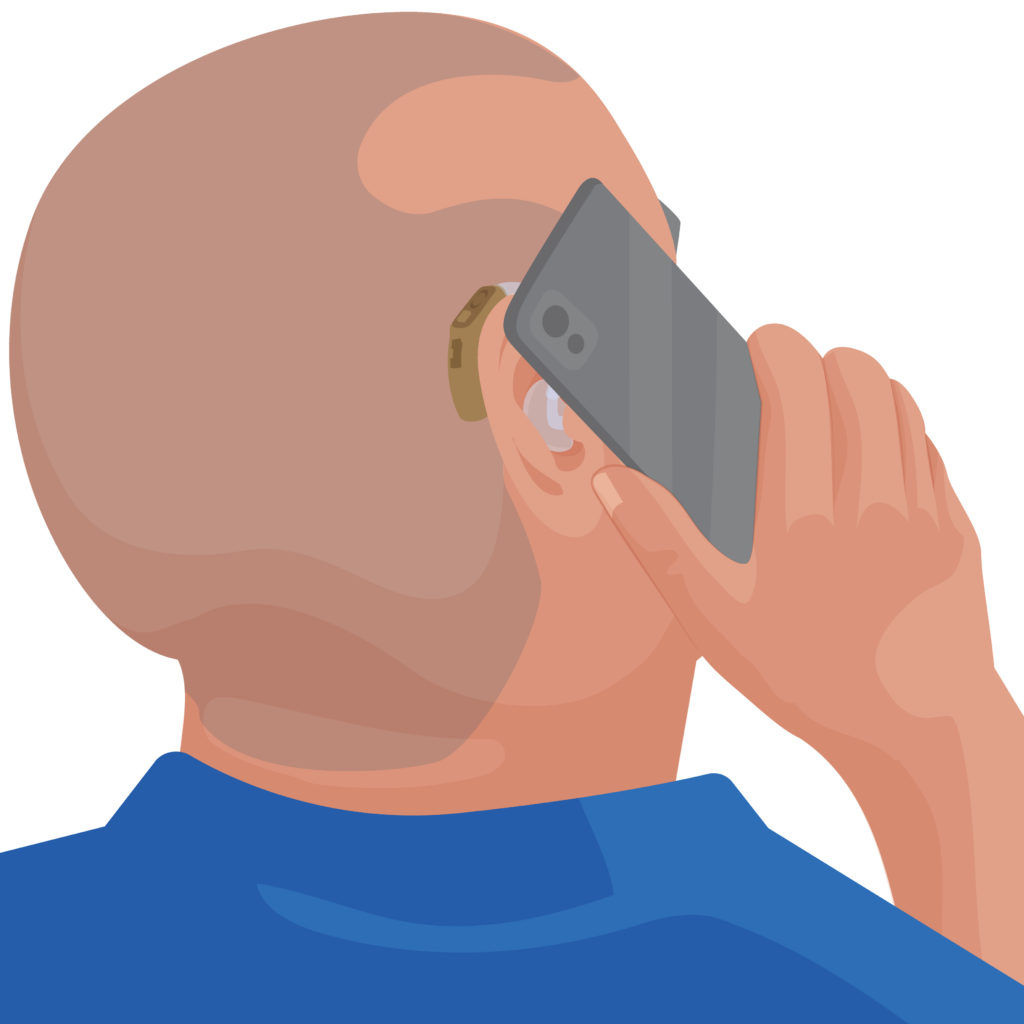There are seven common problems an adult or child may experience with their hearing aids:
- Feedback or whistling sound from hearing aid
- Ear hurts
- Hearing aid/s keep falling off
- Discomfort from very loud sounds
- Difficulty hearing conversations
- Hearing aid not working/sometimes not working or is not as loud as before
- Difficulty hearing when using a phone.
Instruction
Read on to learn how to resolve these problems for people using preprogrammed and programmable hearing aids.
1. Feedback or whistling sound from hearing aid
A hearing aid can create a whistling or squealing sound (feedback). There are several reasons why a whistling sound may occur.
| Possible cause | Possible solutions |
| Volume too high when putting on hearing aid | Put volume on lowest setting before putting on hearing aid. Increase volume gradually. |
| Problem with earmould fit | Check fit and position. Correct if necessary. |
| Damaged/dirty earmould/ear hook | Clean/replace earmould/earmould tube/ear hook. |
| Blocked ear wax in ear canal | Check inside person’s ear with otoscope. Perform ear washout if necessary. |
2. Ear hurts
A person may report pain when wearing hearing aids. It could be a problem with the earmould or an ear health problem.
| Possible cause | Possible solutions |
| Problem with earmould fit | Check fit. Change earmould size if necessary. |
| Damaged earmould | Check earmould. Replace if necessary. |
| Ear health problem | Carry out ear health screen. |
Remember John?

John lives with his wife Mary and uses preprogrammed hearing aids.
For two weeks he has experienced pain when putting the earmould in his right ear.
The health worker checks the hearing aids. There is no sign of damage. There is some ear wax in one of the earmoulds which they remove. The fit of the earmould is good.
The health worker does an ear health check and finds John has a blocked ear canal in his right ear. With his permission they do an ear washout.
John says his ear is comfortable now when he puts on his hearing aids.
3. Hearing aid/s keep falling out
A person may report that their hearing aid/s keep falling out.
| Possible cause | Possible solutions |
| Incorrectly putting in hearing aid | Check person is putting on their hearing aid correctly. Correct technique if necessary. |
| Incorrect earmould fit | Check fit of earmould. As children grow the earmould size may no longer fit correctly and the earmould tube may become too short. |
4. Discomfort from very loud sounds
A person may experience discomfort from very loud sounds.
| Possible cause | Possible solutions |
| Very loud noise in environment | Advise the person to remove their hearing aids when in very loud environments such as construction sites or factories. |
| Hearing aid volume turned up too high | Advise the person to reduce the volume to a comfortable level. |
If the person still experiences discomfort, discuss with your mentor.
5. Difficulty hearing conversations
A person may have difficulty hearing conversations.
| Possible cause | Possible solutions |
| Background noise in environment | Advise the person on tips to improve hearing in noisy environments. Consider a personal remote microphone system (if available). |
| Problem with hearing aids | Check their hearing aids. See problem solving solutions for ’hearing aid not as loud as before’. |
Tip
Try to keep background noise to a minimum, especially at work or school:
- Discuss this with colleagues
- For a child, discuss with their teacher and explain sitting near the front of the class may help.
Instruction
Learn how to improve hearing aid use in noisy environments in the TAP Personal remote microphone systems module.
6. Hearing aid not working/sometimes not working or is not as loud as before
If the hearing aid is not working properly, it may be switched off or there may be a problem with parts of the hearing aid. It may also be positioned incorrectly on the person’s ear.
| Possible cause | Possible solutions |
| Hearing aid switched off | To switch on the hearing aid, make sure the battery is inserted correctly, and the battery door is closed. |
| Low battery power | Replace battery if necessary. |
| Hearing aid is dirty | Clean the hearing aid, earmould and/or battery compartment. |
| Damaged earmould | Replace earmould/earmould tube if necessary. |
After problem solving, check the hearing aid is working correctly using a listening tube:
- If there is still a problem, send the hearing aid for repair.
- If the hearing aid is working correctly and the person does not hear sounds as well as before their ear may be blocked with ear wax. Check by completing an ear health screen. Washout ear if necessary.
Remember Malicka?

Malicka is returning for her two year follow up.
She is not satisfied with one of her hearing aids. It is not working as well as before. The sounds are not as loud even when she adjusts the volume.
The health worker checks the hearing aid with a listening tube and agrees the sounds are quiet.
The health worker changes the battery and notices the battery compartment is dirty. They clean it out and brush the battery pins.
The health worker retests the hearing aid with a listening tube. The sound level is better. The health worker asks Malicka to put on the hearing aid and asks, “How does that sound?”. Malicka smiles and says it is working well like it did before.
7. Difficulty hearing when using a phone
A person who is using hearing aids may have difficulty hearing another person speak on the phone.
| Possible cause | Possible solutions |
| Phone is covering their hearing aid | Advise to use the phone on loudspeaker or try positioning the phone two centimetres away from the hearing aid. |
| Volume setting is set too high or low | Adjust the hearing aid volume as needed. |

If you cannot resolve the problem, discuss with your mentor.
You have completed Lesson five!
Instruction
Once you are experienced in providing preprogrammed hearing aids for adults, take the TAP Programmable hearing aids module to learn how to provide hearing aids for children.